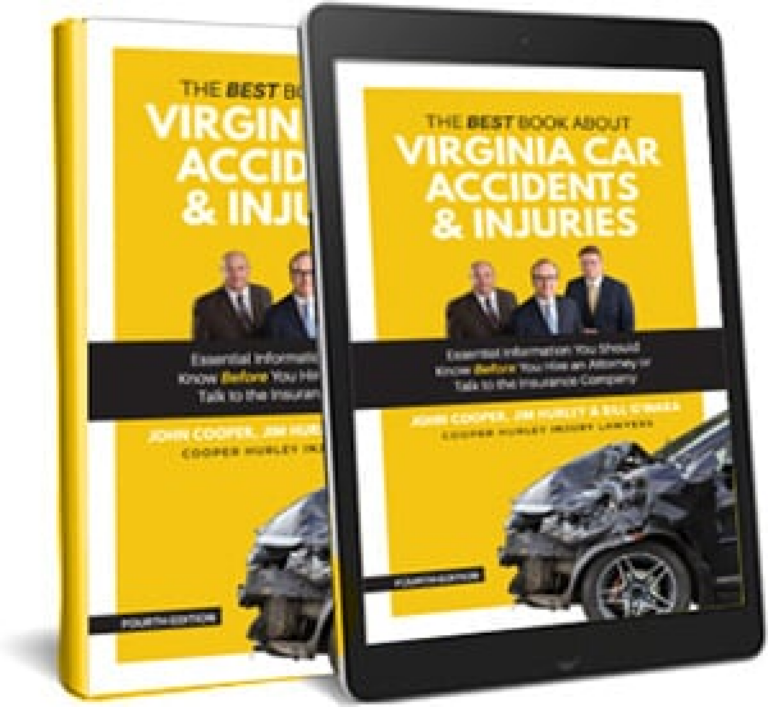Safety Tips for Driving in Inclement Weather

Virginians often get behind the wheel during heavy rain, sleet, and snowstorms. Unfortunately, these drivers are at higher risk of being involved in serious crashes. At Cooper Hurley Injury Lawyers, we want to make sure our clients stay safe when driving in inclement weather. Read on to learn how to maintain your vehicle, build a winter emergency kit, avoid hydroplaning, and more.
Driving in inclement weather can be dangerous and even deadly. Snow, ice, and rain limit visibility and alter road surfaces, making it easier for drivers to lose control. Fortunately, preparation and practice can help you stay safe in these conditions.
At Cooper Hurley Injury Lawyers, we represent folks injured at little to no fault of their own in car accidents. Our Virginia car accident lawyers have developed a strong reputation as The Car Crash Experts in Hampton Roads. Review our safety tips for driving in inclement weather before getting behind the wheel. If you’ve been injured in a car accident, contact our legal team to schedule your free case review.
Overall Tips for Driving in Inclement Weather
Research published in the Bulletin of the American Meteorology Society shows that precipitation increases the likelihood of fatal car accidents by 34 percent. Before driving in inclement weather, plan ahead and review these best practices.
Stay Informed
Check the forecast and road conditions prior to your departure. Then, tune in to a local radio station or program your GPS to deliver updates about detours and road closures as you drive.
Keep a Safe Distance
In severe weather, you face two primary challenges: reduced visibility and poor road conditions. Avoid following too closely behind fellow drivers to ensure you have enough time to brake, change lanes, and avoid hazards. We recommend leaving three times more space between yourself and other cars than you would on a clear day.
Follow State Headlight Laws
Virginia law requires you to turn on your headlights when driving in inclement weather. Specifically, the governing statute requires that your headlights be on:
- From sunset to sunrise.
- When rain, smoke, fog, snow, sleet, insufficient light, or other unfavorable atmospheric conditions reduce visibility to the point where other vehicles are not clearly discernible at a distance of 500 feet.
- Whenever windshield wipers are in use as a result of fog, rain, sleet, or snow.
Communicate With Others
Tell a friend, co-worker, or family member where you’re going and when you plan to arrive. If something happens along the way, they’ll know where to look for you.
Don’t Use Cruise Control
Cruise control is convenient in dry conditions, but it can be dangerous when driving in the rain or snow. The steady speed applied by cruise control can make it difficult to regain control if you lose traction. Control your acceleration and braking manually to ensure safety when driving in inclement weather.
Know Your Vehicle
Some vehicles just aren’t equipped for driving in cold weather. If you own a sports car, for example, you probably won’t want to risk driving through a snowstorm. Know your vehicle’s limits before deciding to hit the road.
Winter Weather Driving Safety Tips
To help you stay safe, follow the Occupational Health and Safety Administration’s “Three P’s of Safe Winter Driving”:
- Prepare for the trip
- Protect yourself
- Prevent crashes on the road
If you were injured in a car accident, we can answer any questions you may have about your legal rights and options in your free consultation. It is best to consult with a skilled personal injury lawyer as soon as possible after an accident.
Slow Down
Reducing your speed gives you more time to react in wet, snowy, or icy conditions. In winter weather, you can maintain better control of your vehicle by accelerating gently and braking gradually. Sudden motions increase the risk of losing control on slippery roads.
Beware of Bridges and Overpasses
Cold temperatures penetrate bridges from above and below, causing them to ice over before other road surfaces. Stay vigilant when driving across these structures. Choose alternate routes when possible.
Clear Ice off Your Windshield
Remove all traces of ice and snow from your vehicle prior to driving in cold weather. Ice on your windshield and windows drastically reduces visibility, and heavy snow cover on top of your car can pose a risk to other drivers.
Pack Emergency Supplies
When driving in inclement weather, always prepare for worst-case scenarios. Dress warmly, charge your cell phone, and pack the following:
- Snow Shovel – Essential for digging your car out of snow.
- Ice Scraper and Snow Brush – For clearing ice and snow from windows and mirrors.
- Sand or Cat Litter – Provides traction if your car is stuck in snow or ice.
- Salt – Helps melt ice around tires.
- Windshield Washer Fluid (Winter Formula) – Prevents freezing and improves visibility.
- Jumper Cables – Useful if your car battery dies in cold weather.
- Tire Chains – Improve traction in snow and ice for vehicles without winter tires.
- Flashlight (and Extra Batteries) – For visibility during night-time or low-light conditions.
- Blankets – Keep you warm if you’re stranded in cold temperatures.
- Emergency Flares or Reflective Triangles – Increase your vehicle’s visibility to others in low-visibility conditions.
- First Aid Kit – For any minor injuries or medical needs.
- Portable Charger – To keep your phone charged for emergency communications.
- Extra Clothing and Gloves – To stay warm if you need to leave your vehicle.
- Non-Perishable Snacks and Water – In case you’re stuck for an extended period.
- Rain Poncho – Useful in heavy rain or snow.
- Umbrella – For protection from rain while outside the car.
- Waterproof Matches or Lighters – Can be critical for warmth in emergency situations.
Having these tools in your car can be very useful when facing inclement weather on the road, ensuring both your safety and comfort.
Plan Your Route: Check With the Virginia Department of Transportation
Always check your route before driving in winter weather. The Virginia Department of Transportation’s online portal provides up-to-date information about traffic speeds, weather conditions, and crashes throughout the state. The site also offers live camera feeds of major roadways. Take a moment to review this information and adjust your plans accordingly.
Prepare Your Vehicle
If you are anticipating winter weather, you should make sure your vehicle is in good condition for driving. For example, you should:
- Check the Battery – Cold weather can reduce battery power. Have your battery tested and replaced if necessary.
- Replace Wiper Blades – Install heavy-duty winter wiper blades to handle ice and snow.
- Check Wiper Fluid – Use an antifreeze wiper fluid to prevent frost on your windshields.
- Check Tire Tread – Ensure your tires have adequate tread for traction in snow and ice. Consider winter tires for better grip.
- Adjust Tire Pressure – Cold air can lower tire pressure. Keep tires properly inflated according to the manufacturer’s recommendation.
- Inspect Lights – Make sure all lights and signals are working for visibility on shorter, darker days.
- Switch to Winter Oil – If you live in an extremely cold area, consider switching to a thinner, less viscous oil.
- Examine Belts and Hoses – Cold air can weaken belts and hoses, so inspect yours for wear and tear.
- Check Antifreeze – Ensure your coolant system is filled with a 50-50 mix of water and antifreeze.
- Keep Gas Tank At Least Half Full – This prevents the fuel line from freezing and helps prepare for unexpected delays.
- Ensure Heater and Defroster Work – This will spare you from being stuck in cold weather without heat and that your windshield stays clear.
By taking these steps, you can ensure your vehicle is equipped to handle winter weather, reducing the risk of accidents or breakdowns.
Tips for Driving in the Rain
Driving cautiously in rain is crucial because wet conditions reduce tire traction, increasing the risk of skidding. Visibility is also impaired by heavy rainfall. Slower speeds and increased following distances are necessary to compensate for longer stopping distances and reduced reaction time.
Keep Wipers On
Visibility is a major concern during heavy rain. Whenever you see signs of precipitation, turn on your windshield wipers. Set them to an appropriate speed and leave them on until conditions improve. Replace your wipers regularly to ensure optimal performance.
Don’t Drive Through Flooded Areas
The National Weather Service’s Turn Around Don’t Drown® campaign encourages drivers to understand the dangers of flooded roadways. Just one foot of moving water can carry away your car. Do not attempt to cross a flooded area.
Brake Slowly and Early To Avoid Hydroplaning
Slamming on the brakes can lead to hydroplaning. To keep your car from skidding, avoid sudden movements. Again, accelerating and braking slowly will help you maintain control of your vehicle on wet or slippery surfaces.
Know How To React
When roads get slick, your car can lose traction. “Overcorrecting” can result in a collision. Stay calm, ease off the gas, and steer slightly in the direction your car is skidding. Once you regain control of the vehicle, pull over and collect yourself before proceeding.
Rely on the Car Crash Experts at Cooper Hurley Injury Lawyers for Safe Driving Tips
We hope these safety tips for driving in inclement weather have been helpful. Remember, if you were injured in a car accident at little to no fault of your own, you may be able to seek legal compensation. The legal team at Cooper Hurley Injury Lawyers is here to ensure you know your full legal rights and options.
Our Virginia car accident lawyers have recovered millions of dollars in settlements and verdicts for our clients. Let us put our legal knowledge and experience to work for you. Contact us today to schedule your free, no-obligation consultation.
Free eBook

Get a free copy of “The Best Book About Virginia Car Accidents & Injuries”
Learn what to do after an accident, how to deal with insurance agencies, and when to get help. Download your free copy of The Best Book About Virginia Car Accidents & Injuries.
Testimonials





